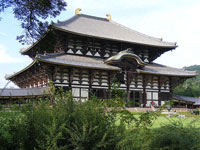Todaiji ("Great Eastern Temple") is a significant landmark of Nara and one of Japan's most historically famous Buddhist temples.

Constructed in 752, Todaiji served as the head temple of all provincial Buddhist temples of Japan. However, it grew so powerful that the capital was moved from Nara to Nagaoka in 784 in order to lower its influence on government affairs.
Today, Todaiji houses Japan's largest Buddha statue (Daibutsu). Within its compound is the world's largest wooden building, even though the present reconstruction of 1692 is only two thirds of the original temple's size.
History
The beginning of building a temple in where the huge Todai-ji complex sits on today can be dated back to 743, when Emperor Shomu established Kinshosen-ji as an appeasement for Prince Motoi, his first son with his Fujiwara clan consort Komyoshi. Prince Motoi died a year after his birth.
During the Tempyo era, the people, and the Emperor suffered from disasters and epidemics. It was after experiencing waves of troubles, that Emperor Shomu issued an edict in 741 to promote the construction of Provincial temples throughout the nation. Todai-ji (still Kinshosen-ji at the time) was appointed as the Provincial temple of Yamato Province, and the head of all the Provincial temples. With the alleged coup d'etat by Nagaya in 729, the smallpox at around 735 - 737, worsened by consecutive years of poor crops, then followed by a rebellion led by Fujiwara no Hirotsugu in 740 ---- his reign was so unstable that Emperor Shomu had moved the capital four times by himself alone.[2]
Initial Construction
In 743, Emperor Shomu issued a law in which he stated that the people should proactively be involved into the making of the new Buddha to protect themselves. He believed Buddha's power could help the people. Gyoki, with his pupils, have travelled provinces asking for donations. According to records kept by Todai-ji, more than 2,600,000 people in total helped construct the Great Buddha and its Hall.[3][4] The 16 m (52 ft)[5] high statue was built through eight castings over three years, the head and neck being cast together as a separate shell 12 feet high.[6] The making of the statue has started first in Shigaraki. After having met multiple casualties as fires and earthquakes, the construction was eventually resumed in Nara in 745,[3] and the Buddha was finally completed in 751. A year later, in 752, the eye-opening ceremony was held with an attendance of 10,000 people to celebrate the completion of the Buddha. The Indian priest Bodhisena performed the eye-opening for Emperor Shomu.
In 754, ordination was given by Ganjin, who arrived in Japan after overcoming hardships over 12 years and 6 attempts of crossing the sea from China, to Empress Koken, former Emperor Shomu and others. In spite of Emperor Shomu's original wish, however, having consumed most of Japan's bronze production for several years the country was left almost bankrupt.
Reconstructions post-Nara Period
The central statue has been recast several times since for various reasons including earthquake damage, and the Daibutsuden rebuilt twice after fire. The current hands of the statue were made in the Momoyama Period (1568-1615), and the head was made in the Edo Period (1615-1867).
The current building finished in 1709 although immense is actually 30% smaller than its predecessor. The original complex also contained two 100 m pagodas, probably the tallest buildings in the world at the time behind the pyramids. These were destroyed by earthquake. The Shosoin was its storehouse, and now contains many artifacts from the Tempyo period of Japanese history.
The dancing figures of the Nio, the two 28-foot-tall guardians at the temple entrance, were closely evaluated and extensively restored by a team of art conservators in 1991. The Nio are known as Ungyo, which by tradition has a closed mouth, and Agyo, which has an open mouth. At that time, These 12-century sculptures had never before been moved from the niches in which they were originally installed. This complex preservation project, costing $4.7 million, involved a restoration team of 15 experts from the National Treasure Repairing Institute in Kyoto.
Source
- Wikipedia
What to see
Various buildings of the Todai-ji were utilized in the garden architecture of adjacent villas. Some of these are now open to the public and provide an important adjunct to the appreciation of the temple complex itself, which over the centuries had become part of a greater organic and aesthetic community.
Among the major buildings on the Todai-ji ground are:
Buildings classified National Tresure
- Kon-do (Daibutsuden)
- Nandaimon
- Kaizan-do
- Shoro
- Hokke-do (Sangatsu-do)
- Nigatsu-do
- Tegaimon



